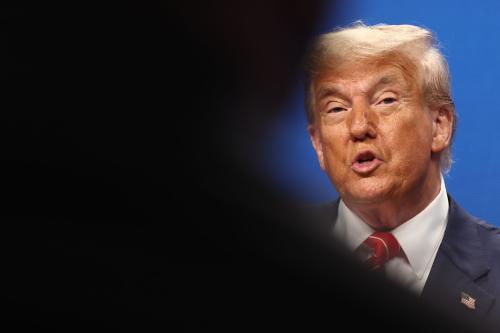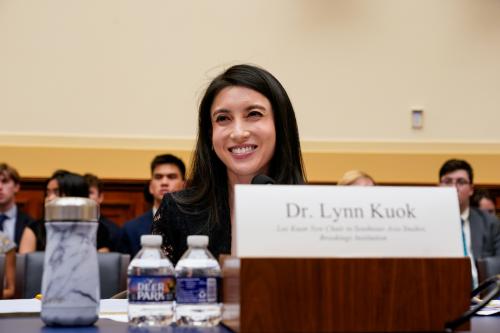The year 2002 is shaping up to be an epoch-making one for East Asian economic integration. Remarkably, the tensions that characterized economic relations in the region in 2001 gave way by year’s end to substantial momentum for greater economic integration.
Tokyo and Beijing solved their dispute over Japan’s safeguards on three agricultural items and China’s retaliation before the deadline to take the case to the World Trade Organization (WTO). China wanted to avoid the WTO dispute settlement and Prime Minister Koizumi Junichiro wanted to avoid confronting China; instead, he insisted on solving the dispute through consultation. Koizumi’s leadership overcame the resistance of Japan’s powerful agricultural lobby and the two countries were creative and flexible enough to devise a WTO-consistent formula that allowed for coordination between producers of both countries.
On the currency front, Japan’s weak economic fundamentals, the Bank of Japan’s loose monetary policy, and the authorities’ willingness to let the yen adjust to levels justified by those fundamentals have driven the yen substantially down against the U.S. dollar toward the end of 2001 and will continue to do so. Asian countries, especially Korea, whose exports compete with those of Japan, criticized this “weak yen policy.” This tension, however, has prompted moves for closer dialogue among regional currency authorities.
The November 2001 agreement between China and ASEAN to negotiate a free trade agreement (FTA) sent a shock wave throughout Japan. Some speculated that Japan might try to block this initiative, which could deal a blow to Japan’s regional leadership. Yet on the contrary, Prime Minister Koizumi welcomed strengthened relations between China and ASEAN and proposed a Japan-ASEAN comprehensive economic initiative—which would include a Japan-ASEAN FTA—in his recent speech in Singapore. In the same speech, he made clear that Japan-ASEAN cooperation should be linked to East Asian cooperation as a whole, with ASEAN, Japan, China, Korea, Australia, and New Zealand at its core.
It is remarkable that the competitive tension between China, Japan, and Korea created enhanced momentum for regional cooperation.
The coming year provides regional leaders opportunities to push even further ahead. Prime Minister Koizumi has just finished his visit to five ASEAN countries. This year marks the 30th anniversary of the normalization of Japan-China diplomatic relations, and Japan and South Korea will co-host the 2002 World Cup soccer tournament beginning in late May. Many leaders, including Koizumi and Chinese President Jiang Zemin, are expected to attend the May 31 opening ceremony in Seoul. These opportunities and annual regional gatherings toward the year-end, such as the 10th APEC (Asia Pacific Economic Cooperation) leaders’ meeting to be held in Los Cabos, Mexico on Oct. 26-27 and the ASEAN Plus Three Summit (the meeting among leaders of the 10 countries of the Association of Southeast Asian Nations, plus China, Japan, and South Korea) on the margins of the Eighth ASEAN Summit to be held in Phnom Penh, Cambodia later this year, will give a political push to East Asian economic integration.
At the same time, regional powers continue to compete and this competition still seems stronger than the impulse to cooperate to achieve common goals. Therefore, it will take a long time for region-wide institutions such as the East Asian Free Trade Area to move beyond political statements. Thus, it is probable that competitive bilateral or smaller, multilateral agreements in and outside the region will be developed in parallel. Through their interaction, a region-wide framework—as well as a sense of community—will evolve, while competition will stimulate regional economies to overcome domestic resistance to reform and liberalization so as not to become marginalized.
This model of competitive regional cooperation or multi-layered regional framework seems particularly appropriate for Asia, where diversity as well as competition among regional powers prevents a full-fledged, European-style economic integration. This approach can provide a model for a global rule-making process since local efforts toward creating a more business-friendly environment interact and stimulate global efforts.
There is another dimension to this effort. If Asian economic integration can combine liberalization and rule making with assistance to developing economies that will help them participate in regional economic integration, it will also provide insights on how to integrate poorer countries into the global economy. Making those countries viable players in the global market is preferable to making them dependent on assistance. This is not the same as “appeasement” to get a trade deal.
East Asian leaders should not let this historic opportunity slip away. Economies outside the region should not miss the opportunity to influence this open and dynamic process of evolving East Asian economic integration.
The Brookings Institution is committed to quality, independence, and impact.
We are supported by a diverse array of funders. In line with our values and policies, each Brookings publication represents the sole views of its author(s).



Commentary
Op-edSeize the Moment for East Asian Economic Integration
February 1, 2002